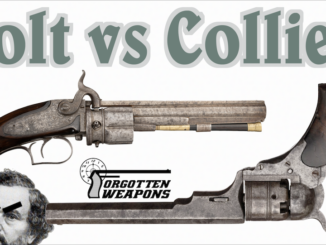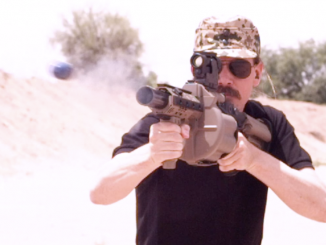This is lot #1474 in the upcoming RIA Premier Auction. It was scheduled for April, but has been postponed – check their web site for upcoming Online Only auctions every month, though!
The Colt 1902 Military model was a more popular pistol than some folks might expect, and remained in production well after the introduction of the various .45ACP caliber Colts. It was also rather popular in Mexico – shipments to Mexican dealers accounted for about 2400 guns, roughly 13% of total 1902 Military production. Many of these went to the Mexican military, including 800 specially ordered with mother of pearl grips and a Mexican national crest engraved on the top of the slide. This is an example of a gun from that order – definitely not the look you would expect for a formal military contract!




Browning’s stuff has been everywhere!! Just kidding.
Back when I as a rookie on the PD, we responded to an alarm at the local High School at around 2 AM one morning. It was a false alarm but we had to clear the building, which for a 4 man PD took some time. The Chief, who was a young officer, a couple years my junior showed up with his off duty weapon, after we cleared the building we were gathered near the school office when he displayed his pistol, a Nickeled Colt Combat Commander in 38 Super. It was the first Combat Commander I ever saw, and the first 38 Super I ever heard of. Come to think of it, it was the last .38 Super I ever saw, and the last Combat Commander in Nickel that I ever saw as well. Ah for the good old days, this was in 1973.
I remember seeing pictures of one of those before, back in the 70s. Almost certainly Officer’s issue !
Ads at the time claimed the .38 ACP with a 105 grain FMJ bullet had a muzzle velocity of 1,300 feet per second, giving a muzzle energy of 400 foot-pounds.
To put this in perspective, the standard u.S. Army loading of the .45 Colt revolver cartridge launched a 255-grain RNL bullet at 850 F/S for 410 FPE.
So the .38 ACP was officially one of the most powerful handgun cartridges on Earth at the time.
Of course the ads, such as in the 1902 Sears & Roebuck mail-order catalog, also said the .38 Colt Automatic was accurate and effective out to 500 yards. That was probably a bit overly optimistic.
Ezell (Handguns of the World, Stackpole, 1981) lists both the .38 ACP and .38 Super as having a 130-grain FMJ bullet, with the .38 ACP launching it at 1,040 F/S for 313 FPE and the Super upping that to 1,270 F/S for 465 FPE.
Considering that 1,300 F/S and 400 FPE was considered the standard for the .38 Super Automatic round when it was introduced in 1929, I’m wondering just who was writing the ad copy in 1902. And what the statistics of the original .38 Automatic Colt Pistol cartridge actually were.
cheers
eon
“hat the statistics of the original .38 Automatic Colt Pistol cartridge actually were.”
STANDARD BALLISTIC OF KYNOCH CENTRAL-FIRE METALLIC CARTRIDGES states
DESCRIPTION: ·38 Automatic Pistol
POWDER: 6 grs. Smokeless
BULLET: 130 gr. Metal-covered
Muzzle Velocity: 1,050 Ft. per sec.
Muzzle Energy: 318 Ft. lbs.
sadly test barrel length is unspecified, which might influence muzzle velocity.
Note that in term of momentum 105@1300 is equal to 130@1050 (150*1300=130*1050) but note similarity of these:
105 – 1300
130 – 1050
this lead to my suspect that this might be typographical error and STANDARD BALLISTIC OF KYNOCH CENTRAL-FIRE METALLIC CARTRIDGES is correct. Another possible explanation might be that different loading were offered – lighter faster bullet and heavier slower bullet – and that first was found to be more appealing to customers by advert author.
Actually, the 105 gr. weight came from the listing in the cartridge part of the catalog (p.323). The Sears ad writer might have screwed up the MV in the sales ad for the pistol (p.319), but I’m pretty sure the sporting goods department would have gotten the bullet weight correct.
https://www.amazon.com/1902-Sears-Roebuck-Catalogue-Co/dp/B000K6ZIWY
cheers
eon
A pair of these(obviously not the originals)were wielded by Fernando Lamas in the 1969 movie 100 Rifles. Even at my (then) tender age I recognized them as pre 1911 Colts.
The corrupt as hell Mexican government called, they want their pimp gun back.
Ha! Imagine if a tough guy American general carried
ivory handled pistols around.
The screaming unanswerable question? Why did the authority ordering these guns for Vera Cruz want a batch with pimp-grips? They can’t have been for general issue. Was there some circle of cronies who wanted them? Were they to be distributed as special favors?
High-rankers in Mexico seemed to always want fancied-up pistols.
Colt made several short runs of M1873s for sale to the Mexican government in .44 Henry rimfire from 1874 to 1895 or so. (Winchester 1866s were popular down there for a long time.) Most were delivered with blued finish and wood grips.
Surviving ones today generally have nickel-chromium finish, 14K gold accents on hammers, triggers, etc., often are engraved, and almost invariably have “Mexican eagle” grips made of ivory, mother of pearl, or even silver or gold. The latter often inlaid with turquoise or etc.
I might add that like Colt-supplied “Tiffany” grips on Peacemakers, the fancy “aftermarket” precious-metal grips are very much for show, not shooting. Firing heavy, even blackpowder, .45 Colt or .44 WCF loads with those grips requires leather shooting gloves, unless you really like having to bandage your palm afterward.
cheers
eon
Have you ever been to Mexico? Seeing police strutting around with ivory or mother of pearl grips is a thing there. Part of the culture.
Have we any proof that this .38 ACP Colt came from the factory like this? It would not be too hard to put some new grips on an issued pistol after all. See also those perspex grips with a photo found on some WW2 M1911 A1.
Generals get what they want. US Air Force Security Police at Headquarters, Strategic Air Command, Offutt AFB, had S&W Model 15s with pearl grips from the 1950s until replaced with Beretta 92s. The rest of the Air Force made do with wood grips.
Trust Ian to solve the mystery of why Mexican-Americans prefer 1911s in .38 Super w/ mother of pearl grips – they’re just another group of retro cloners.
Mexico’s President from 1884 to 1911, Porfirio Diaz, was quite the gun nut and really liked them fancy. Here’s his Evans-
https://www.rmc-cmr.ca/sites/default/files/rmcc/cam/mus/images/rifle-fusil.jpg
Much of his collection is held at the Royal Military College of Canada- well worth a visit.
https://www.rmc-cmr.ca/sites/default/files/rmcc/cam/mus/images/rifle-fusil.jpg
How did the collection end up in Canada? And you have posted the same link twice btw.
Oops. Here’s the RMC museum website-
https://www.rmc-cmr.ca/en/museum/collections-history-gallery#dou
At the beginning of the last century, ivory and mother of pearl were not yet scarce material.
Colt (and other manufacturers) offered both ready-made pistols in a “gift” version, and parts separately.
https://i.pinimg.com/originals/8b/bf/c5/8bbfc55b98702b4366e610251530e623.jpg
Bone instead of wood, often preferred not for beauty. Since there was no chemistry, wooden handles rotted and worn out.
Good point. Mother of pearl is also more resistant to moisture and should resist sweaty hands as well. But hard vulcanised rubber was also already a thing. Makes me wonder why Colt (or the aftermarket) did not offer such an option?
Ebonite is fragile and much less durable than bone.
Well, the price.
Polymer casting, in addition to the polymers themselves that need to be taken somewhere, requires foundry equipment. Extruder and mold. And they are VERY not cheap.
And bone parts can be made on the same equipment as wooden.